
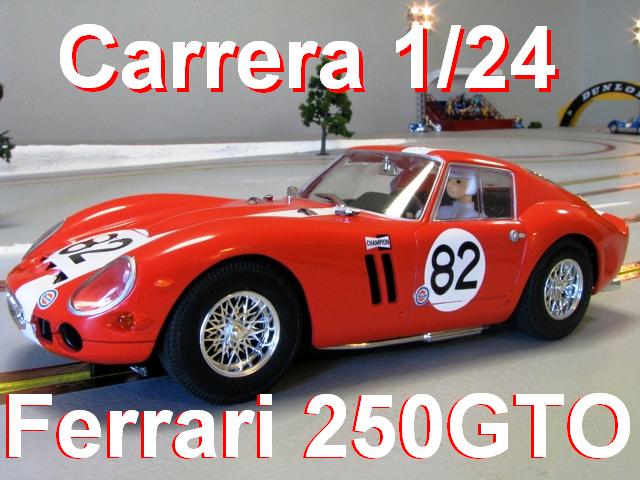 Carrera 1/24 Ferrari 250 GTO Review By Alan Smith 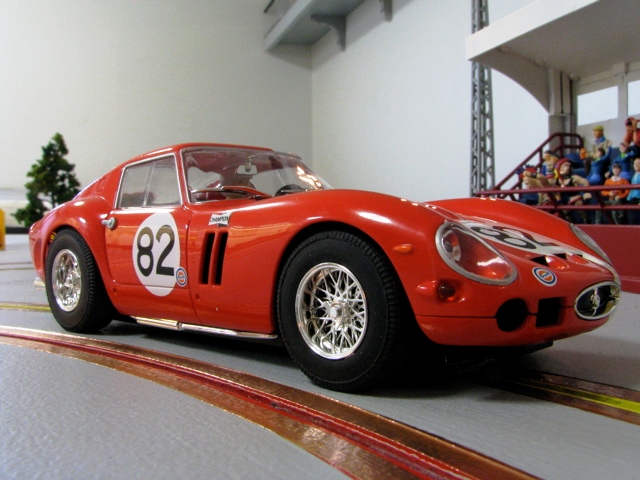 Gran Turismo Omologato, or GTO, is a spoonful of automotive alphabet soup, and one that every motor head dreams about. GTO is Italian for Grand Touring Homologated, a racing series for production-based autos that must meet strict technical standards and minimum street legal production numbers before completing. The Ferrari 250 GTO won the World Manufacturer's Championship series in 1962, 1963, and 1964. In 1962 a GTO driven by Phil Hill and Olivier Gendebien finished second overall in the tough 12 Hours of Sebring endurance race. These, and many more racing triumphs were achieved by a total production ntof 39 cars. The Ferrari 250 GTO became a legend the old fashioned way, by winning races. 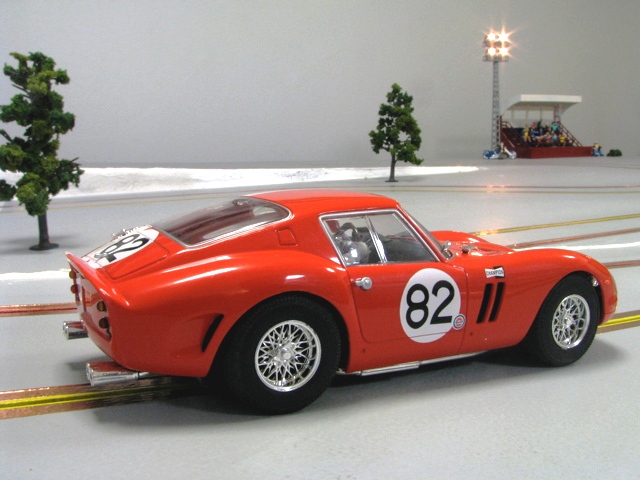 The GTO modeled by Carrera was raced by privateers Bill Eve and Larry Perkins in the 1962 12 Hours of Sebring. While it didn’t win the race, Carrera made the right choice in picking this livery. Painted red with a bold white racing strip, wire wheels, and a chrome prancing horse on the front grill, this model certainly has that classic Ferrari look. My first impression was “Wow”; this is a nice looking model. Carrera has accurately captured the graceful yet aggressive lines of this classic racer. 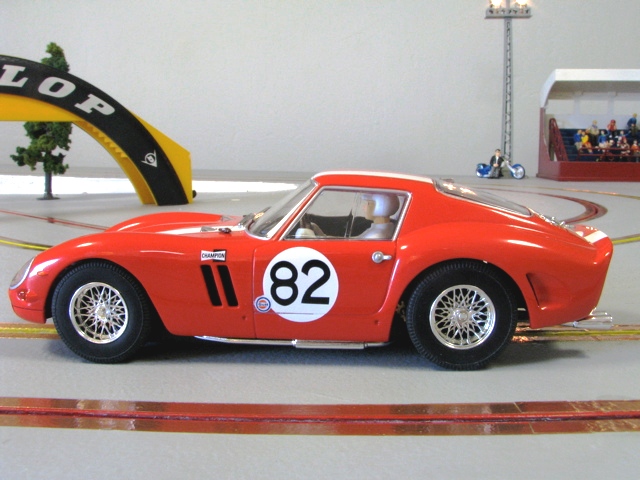 Moving in from the twenty-four inch view, let’s examine the GTO up close. The red paint is flawless and the white trim is crisp and opaque with the exception of some unevenness the lower nose area. Sponsor advertising was more sedate in the sixties and this GTO has only small Gulf and Champion logos applied. Slot car enthusiasts love Gulf logos, but the four found on the doors and nose of this model look like an after thought, too much white space and printed slightly off-center. 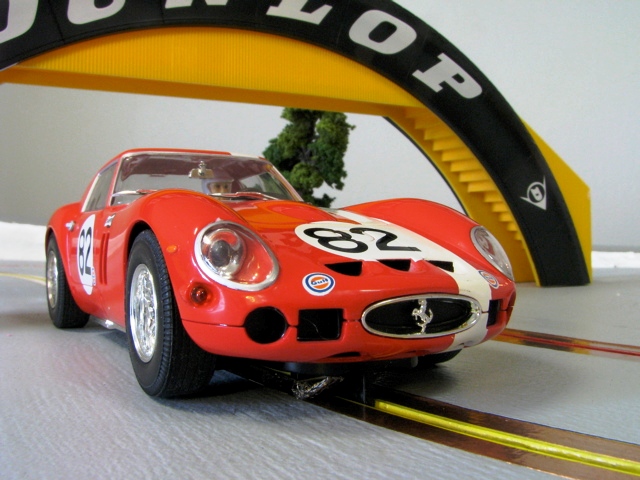 Up front the GTO is busy with detail, the oval air intake is trimmed with chrome and surrounded by ten additional air scoops. The headlight covers are flush with the fender curves but marred by small nubs of molding flash. The perfectionist with a sharp blade and a steady hand could easily remove these offending nubs. Moving up the long nose we arrive at the pontoon fenders and power bulge that this car is known for. The two clear scoops on the hood are applied from under the body and could be better sculpted to hide the thick clear plastic material. The leather hood latches look great. 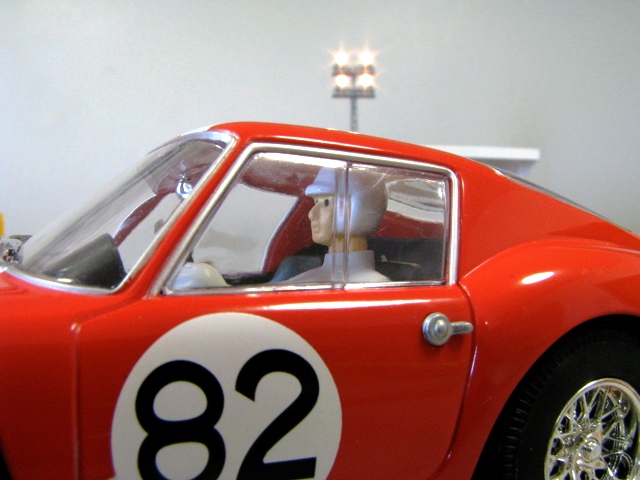 The large windshield gives a clear view of the driver in the two-seat cockpit. He’s painted white from helmet to gloves, with a pair of large black eyes almost anime in appearance. Again the perfectionist will want to give him a do over. On the plus side he’s wearing an open face helmet and holding a brown rimmed three spoke steering with a yellow and black Ferrari logo in the center. The half tray cockpit also features a rear view mirror, white on black instruments, a row of oversized toggle switches, and a shifter on the transmission tunnel. 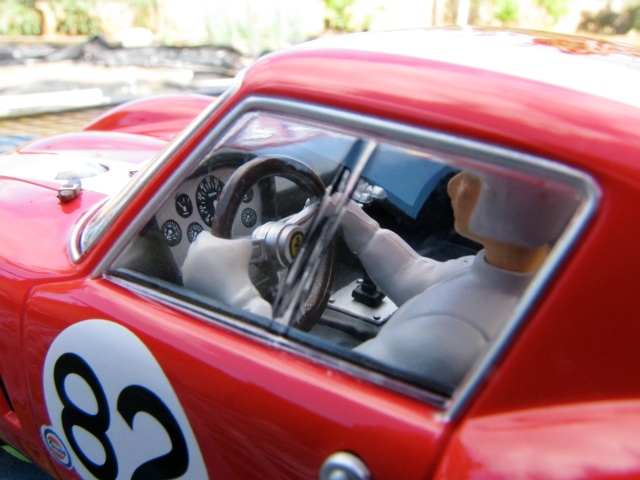 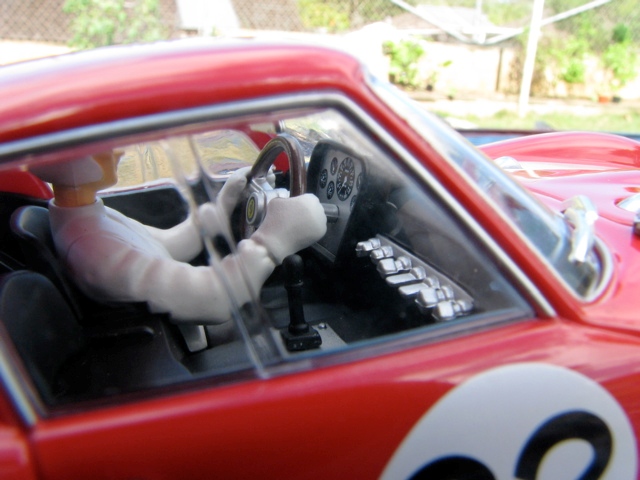 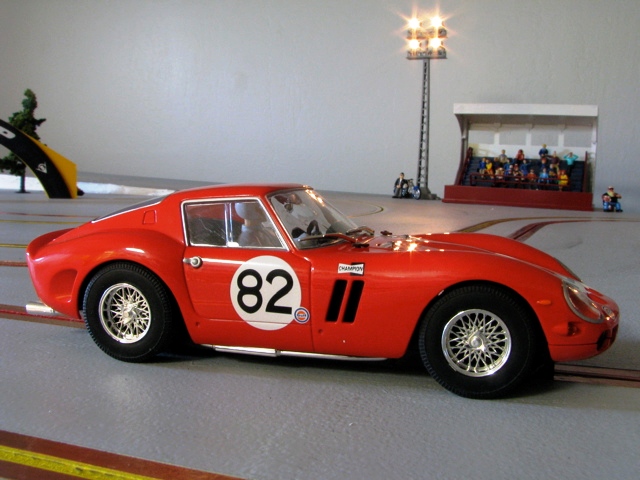 Chromed wire wheels, dual slanted air vents, and a chromed exhaust system dominate the side view. Out back there are four taillights, a chrome fuel door, and four detailed chrome exhaust tips. Those with knowledge of the prototype might say the exhaust system on the 1:1 car was finished in flat black and that this model has way too much chrome to be scale. I suspect that’s true but personally I think the chrome looks better. 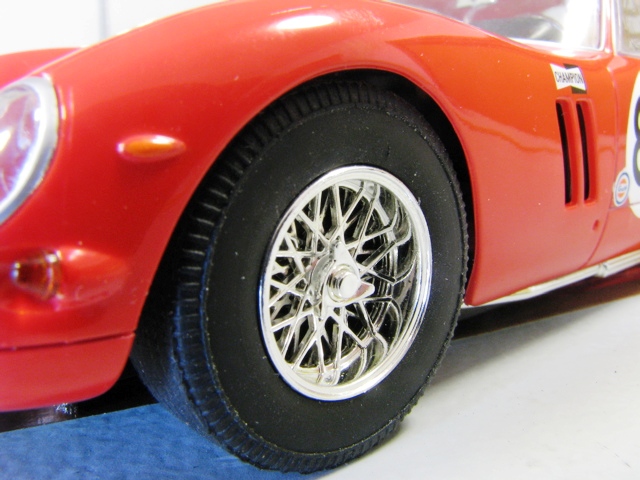 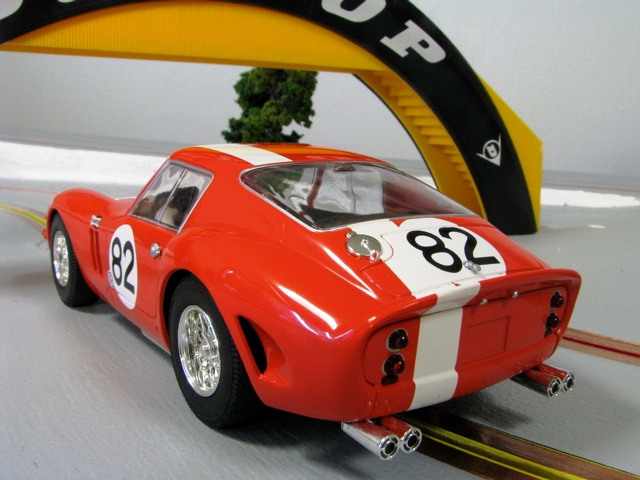 Endurance racing means racing after dark, and this GTO is equipped with lights front and back. There is some taillight bleed through, but nothing too distracting. Out front what struck me immediately was even though the headlights were brightly lit, there were no beams lighting the road ahead of the car. I did notice two small beams shining out from the left and right front wheel wells. Later, during the body off inspection, I discovered what was going on. 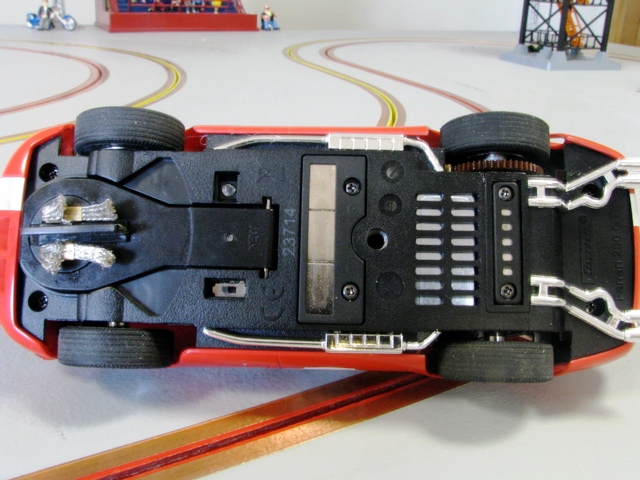 The view down under reveals a large three-piece bar magnet in the center of the chassis and a smaller bar magnet between the rear wheels. The magnets are held in with screws and can be shimmed closer or further from the track, or they can be removed completely. Carrera includes magnet shims, spare pickup brushes, and a spare guide flag. The guide is mounted on a drop arm which normally has about 3/8” vertical travel, but will swing out completely for maintence. The design has evolved since last year and now features a snap-in guide flag. On the track this allows the guide flag to pop out when cornering limits are reached. Another change is the replacement of the conductive wire springs in the drop arm with plain old electrical wires. Those conductive springs had a nasty habit of breaking during hard racing sessions. 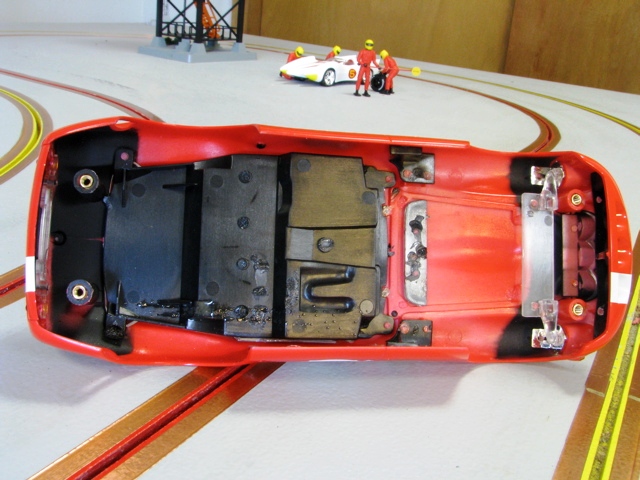 Our look under the hood starts by removing four machine screws that thread into metal body post inserts. With the screws removed the body comes away with ease and feels surprisingly light compared to some other Carrera 1/24 bodies. Take a look at the photos for details of the sidewinder motor setup and digital electronics. Power transfer from the motor is through a brass pinion gear and a fiber reinforced spur gear. Gear mesh is smooth and there is no unwanted play in the front or rear axles. 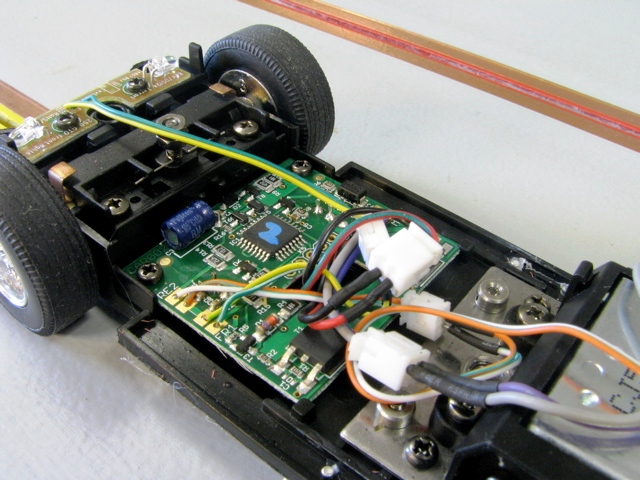 About those front lights, take a look at the above photo of the LED mounting board; the LEDs are mounted so they shine to the left and right, relying on a plastic channel to reflect light out of the headlight covers. It might be time for Carrera to consider surface mount technology to avoid this type of Rube Goldberg approach. 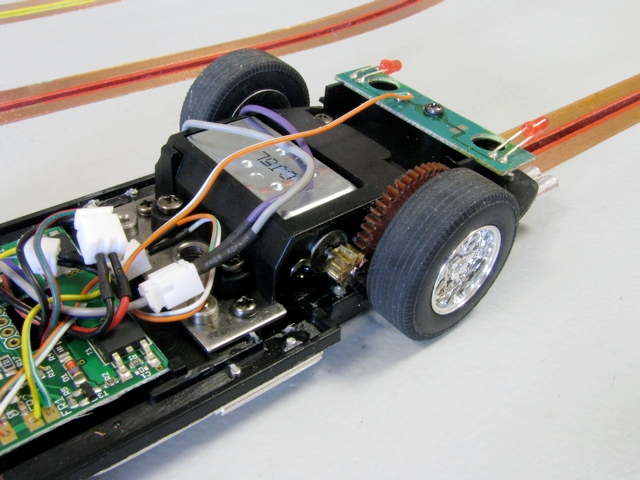  Track testing was done on my routed wood track that is painted with two coats of magnetic paint covered with a coat of flat latex primer. The magnetic paint provides only a fraction of the down force available on a plastic track, but that down force is evenly spread over the entire track surface. I run my cars with magnets, and that’s how this car was tested. The GTO is one of the new Carrera Digital 124 cars that are backward compatible with the first generation digital Pro-X system, and able to run on analogue tracks was well. Switching the car to analogue mode is done by placing the car on your powered up track and giving the car three pulses of voltage with the controller. This worked for me the first time I tried it, and the car has remained in analogue mode ever since. At 18 volts the GTO was very quick, and liked to break loose in small radius turns. 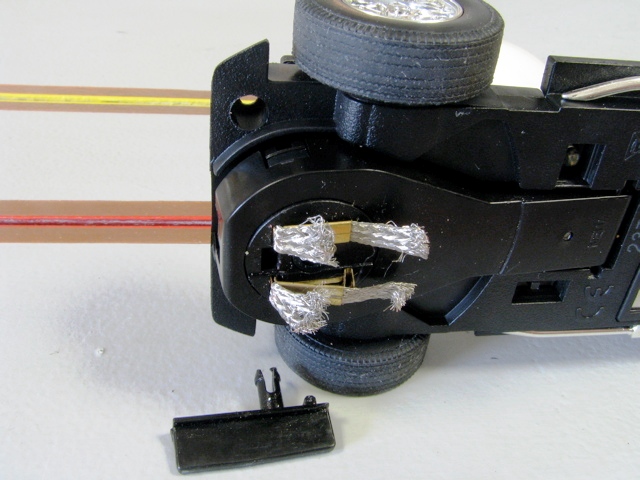 This caused the guide flag to pop out, bringing the car to a stop. Keep in mind that my track has much tighter turns then Carrera plastic track. For my track 14 volts was the sweet spot, just enough zip on the straights and plenty of torque in the turns for controlled drifting. At this voltage the GTO is fun and easy to drive with lap after lap consistency. Best lap time was 5.75, with average times closer to 5.88. My fastest stock 1/24 Carrera is a Porsche 6 that averages 5.72. The Ferrari is the heavier car, weighing in at 160 grams vs. 120 for the Porsche. 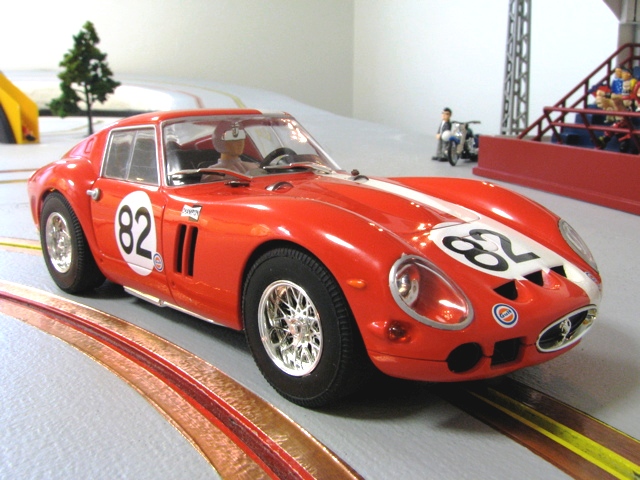 Tuning the GTO was limited to lubrication and checking the rims for excess flash. When removing the left rear tire I was quite surprised when half of the wheel came off with the tire. The wheels are a three-piece design; inner and outer with a thin section of spoke in the middle. I scraped some of the chrome plating off the center and glued it back together using a dab of CA and a clamp. No problem with the other wheels and the repaired wheel is holding together very well. 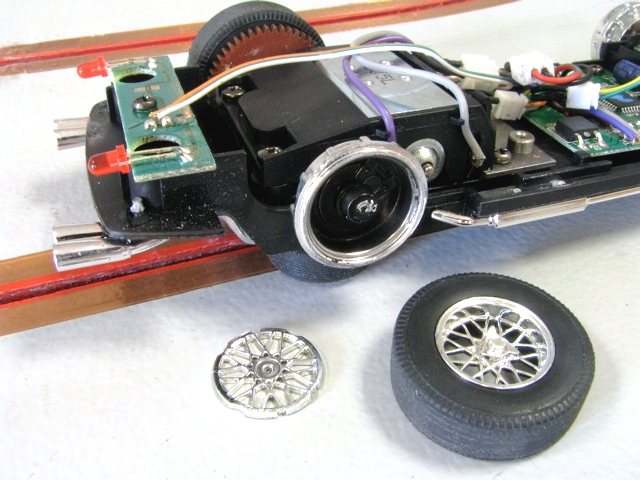 Carrera’s Ferrari 250 GTO is a nicely detailed and finished 1/24 scale slot car. Straight out of the box it’s a quiet and smooth runner with predictable handling. Make no mistake, this is a home track racer, not a fire breathing commercial track scorcher. Carrera 1/24 fans will find the new guide system an improvement, and the digital or analogue compatibility has not compromised analogue performance at all. Carrera still delivers big value for the dollar, which puts this red Ferrari high on my “recommended” list.  Alan Smith - Asmith Email me about this article |